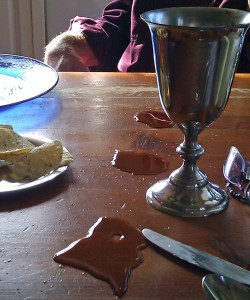 Jesus loves a free atmosphere where He can flow through His people with no hindrances. Amazing revelations happen in an open, Spirit-led gathering. This happened to us recently on a Sunday morning when we were eating together and remembering the Lord.
Jesus loves a free atmosphere where He can flow through His people with no hindrances. Amazing revelations happen in an open, Spirit-led gathering. This happened to us recently on a Sunday morning when we were eating together and remembering the Lord.
Our sweet time together shifted gears suddenly. We each had sipped some wine from the pewter goblet. Dale picked it up, poured some wine out onto the table, and said with conviction, “His crucifixion was not neat, it was very messy.” We were all stunned for a few moments as we gazed at the liquid on the table and reflected on the words he had spoken. Then I said, “Crucifixion is chaotic, unpredictable and violent.” We began to reflect on the great amounts of blood spilled in the sacrificial system of the Israelites. Nancy Leigh DeMoss has captured some key thoughts about the lambs led to the slaughter:
It’s been calculated that over the course of one year, 1,086 lambs were sacrificed in these regular recurring rhythm of offerings. And that’s in addition to other offerings that were made for individual and corporate sin. That’s a lot of lambs being slain. That’s a lot of blood being shed. Lambs killed. Innocent, young, male lambs without blemish slain, killed, slaughtered, and their blood running through the tabernacle. The historian, Josephus, tells us that in the time of Christ that at the time of Passover there would be a quarter of a million Passover lambs that were slaughtered. And the blood of those lambs would flow out through viaducts down into the river, the brook Kidron. As those lambs were being slaughtered on that Passover, a carpenter from Nazareth named Jesus was put to death on a hill outside Jerusalem as the blood of God’s Passover Lamb ran down from His hands and head and feet onto the ground below. (Nancy Leigh DeMoss, “Lamb of God,” April 17, 2014, www.reviveourhearts.com/radio/revive-our-hearts/lamb-god/)
I think we often picture Jesus’ crucifixion as an orderly event that went through various steps until He was left hanging on a tree with two others. There is, however, no polite way to pound crude stakes into human wrists and ankles. There would be blood everywhere in the vicinity of the tree. The jarring nature of the crucifixion does not mesh well with the “comfortable Christianity” most are used to.When Dale poured that wine out onto the table the Spirit of God re-griped us with the unbelievable ugliness of that day in Golgotha. He was in our place as our substitute and when He died, we died with Him. Jesus was poured out as a love offering on our behalf.
I took a picture of the wine on the table. It was not until 1968 that archaeological evidence was found that showed an aspect of the horror of crucifixion, and it is pictured below.
On the Mount of Olives He purchased the ekklesia of God with His own blood. We do not, therefore, belong to ourselves, but to Him who gave Himself for us. Given what He endured in crucifixion, it is no wonder that He asked Father if He could avoid this cup of suffering. It was not a pretty day. It was for sure a violent day. But because the corn of wheat fell into the ground and died, Christ has blossomed all over the world.
In most settings of “the Lord’s Supper,” what Dale did would be condemned as sacrilegious. In an open gathering it became a powerful illustration of the supreme act of love accomplished in the midst of raw hostility. (October 30, 2014)
Jon Zens, November, 2014


 Author, speaker, editor of Searching Together, itinerant encourager of relational communities.
Author, speaker, editor of Searching Together, itinerant encourager of relational communities.
Jon –
What a great illustration and appropriate picture of our Lord’s suffering. Thank you for sharing. I hope to be part of a gathering like that one day soon.